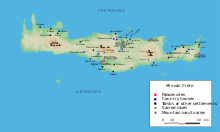Minoan civilisation
 |
|
| Period | Bronze Age Europe |
|---|---|
| Dates | c. 3650 BC – c. 1450 BC |
| Major sites | Knossos, Gortyn |
| Preceded by | Cycladic culture |
| Followed by | Mycenaean Greece |
|
Bronze Age |
|---|
| ↑ Chalcolithic |
|
Near East (c. 3300–1200 BC) South Asia (c. 3000– 1200 BC) Europe (c. 3200–600 BC)
China (c. 2000–700 BC) |
| ↓Iron Age |
Near East (c. 3300–1200 BC)
South Asia (c. 3000– 1200 BC)
Europe (c. 3200–600 BC)
China (c. 2000–700 BC)
arsenical bronze
writing, literature
sword, chariot
The Minoan civilization was an Aegean Bronze Age civilization on the island of Crete and other Aegean islands that flourished from approximately 3650 to 1400 BC, belonging to a period of Greek history preceding both the Mycenaean civilization and Ancient Greece. The period was rediscovered at the beginning of the 20th century through the work of British archaeologist Arthur Evans. The civilization has been referred to as the earliest of its kind in Europe; historian Will Durant dubbed the Minoans "the first link in the European chain".
The term "Minoan" refers to the mythic King Minos, and was originally given as a description to the pottery of the period. Minos was associated in Greek myth with the labyrinth and the Minotaur, which Evans identified with the site at Knossos, the largest Minoan site. The poet Homer recorded a tradition that Crete once had 90 cities.
...
Wikipedia
